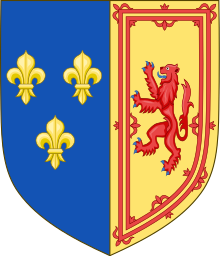Treaty of Edinburgh
TheTreaty of Edinburgh(also known as theTreaty of Leith) was atreatydrawn up on 5 July 1560 between the Commissioners of QueenElizabeth I of Englandwith the assent of the ScottishLords of the Congregation,and the French representatives of KingFrancis II of France(husband ofMary Queen of Scots) to formally conclude thesiege of Leithand replace theAuld AlliancewithFrancewith a new Anglo-Scottish accord, while maintaining the peace between England and France agreed by theTreaty of Cateau-Cambrésis.
French and English troops in Scotland
[edit]The rule ofMary of Guisein Scotland was supported by French troops. Scottish Protestants challenged her rule in theReformation Crisis.During the ensuingSiege of Leith,French troops fortified the port and town of Leith against an English and Scottish Protestant force. The English army was invited into Scotland by theTreaty of Berwickmade by the Lords of the Congregation. The treaty was concluded on 6 July 1560 just short of a month after the death of Mary of Guise. The fortifications at Leith,InchkeithandDunbar Castlewere duly removed, and the French garrisons left Scotland.[1]Other conditions discussed involved the joint use of English and French heraldry byMary, Queen of Scots.[2]
Remains of anartilleryfort involved in the siege were found in 2006 inEdinburgh'sPilrig Park,and two gun emplacements can be seen onLeith Links.[3]
Terms of the treaty
[edit]
The representatives wereJean de Monluc,Bishop of Valence,and Charles de la Rochefoucault, Sieur de Randan, for France, withWilliam CecilandNicholas Wotton,Dean of Canterbury and York.[4]The French deputes were authorised to discuss the withdrawal of their troops with theArchbishop of St Andrews,John Bellenden of Auchnoul,andWilliam Maitlandas representatives of the Congregation. The French delegation was also permitted to meet and console the bereaved ladies-in-waiting of Mary of Guise's court.[5]The cessation of hostilities during the negotiation was marked by two cannon shots fromEdinburgh Castleat 7 o'clock in the evening of Monday 17 June.[6]
It was agreed between France and England that all their land and naval forces would withdraw from Scotland. Mary andFrancis II of Franceshould not use the arms and signs of England and Ireland in their heraldry. Mary and Francis would fulfill the representations made by the nobility and people of Scotland on 6 July 1560.[7]
Ratification
[edit]
The terms of this treaty are occasionally confused with the acts of theReformation Parliamentof 1560 which met in August, and sought to establish the Protestant church in Scotland. However the treaty was notratifiedby Mary Stuart, the reigning Scottish monarch at the time, despite considerable pressure upon her until 1567.[8]Even so, it had the intended effect of the withdrawal of French troops fromScotlandat the time, and the eventual fall of theCatholic Church in Scotland.
Mary may not have wanted the Treaty to be ratified as she was heavily attached to France, having been itsqueen consort,and viewed the Lords of the Congregation as rebels against her mother Mary of Guise. She also did not ratify the treaty because it officially declared Elizabeth the monarch of England, a position Mary desired for herself.[9]TheGowrie Regimeattempted to ratify the treaty in April 1583.
See also
[edit]References
[edit]- ^Calendar State Papers Scotland,vol. 1 (Edinburgh, 1898), p. 444.
- ^HMC Salisbury Hatfield Manuscripts,vol. 1 (London, 1883), p. 240.
- ^Herald & Post (newspaper), Scotsman Publications Ltd., Edinburgh. 7 December 2006.
- ^HMC Salisbury, Hatfield Manuscripts,vol. 1 (London, 1883), pp. 245–246.
- ^Edmund Lodge,Illustrations of British History, Biography and Manners,1 (London, 1791), pp. 320–322.
- ^Edmund Lodge,Illustrations of British History,1 (London, 1791), pp. 329–336, Cecil and Wotton to Elizabeth, 19 June 1560.
- ^Gordon Donaldson,A Source Book of Scottish History,vol. 2 (Thomas Nelson, 1953), pp. 171–172, fromFoedera,vol. 15, 593–597.
- ^Susan Doran,Elizabeth I and Her Circle(Oxford, 2015), 66–67:David Hay Fleming,Mary Queen of Scots(London, 1897), 68–69.
- ^Tom Steel,Scotland's Story: A New Perspective(London: William Collins, 1984), p. 74.
Further reading
[edit]- "Text of Treaty from Haynes (1740), Salisbury-Hatfield Mss".
- Rymer, Thomas, ed. (1713).Foedera, conventiones, literae et cujuscunque generis acta publica inter reges Angliae et alios.Vol. 15. London. pp.581,593–593,601–602.Texts of the Treaty; pp. 581 French commission; pp. 591–3 Order for the demolition of Leith (French); pp. 593–7 Latin treaty, pp. 601–2 English ratification.
- Bain, J., ed. (1898).Calendar of the State Papers relating to Scotland and Mary Queen of Scots 1547–1603.Vol. 1. H.M. General Register House Edinburgh. p.490.
- 1560 in Scotland
- Scottish Reformation
- 16th century in Edinburgh
- 1560 in France
- 1560 treaties
- Proposed treaties
- Treaties of the Kingdom of France
- Treaties of Scotland
- Treaties of England
- France–Scotland relations
- England–Scotland relations
- Auld Alliance
- 1560 in England
- Church of Scotland
- Military history of Edinburgh


